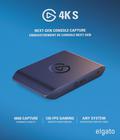When it comes to video capture hardware, we are spoiled for choice. You can find everything from high-end professional gear to super cheap, no-name devices at online stores. Filtering through it all to find hardware that is easy to use and provides gaming-specific features can feel like a challenge in its own right. Elgato's newest release, the Game Capture 4K S, hits the sweet spot of high-quality recording, ease of use, and an affordable price point. Unfortunately, the bundled software still needs a bit of polish.
From a hardware perspective, the Game Capture 4K S looks nearly identical to the higher-end Game Capture 4K X that came out last year. It's roughly the same size as a deck of playing cards, and it has three ports on the back: HDMI In, HDMI Out, and USB-C. The front of the unit has an LED and an analog audio input. The Game Capture 4K S is small enough and light enough to be a portable capture unit while being powerful enough to be part of a permanent capture or streaming setup.
One of the big draws with the Game Capture 4K S is the extremely low latency video preview. Elgato says it is about 30ms, which is nearly imperceptible. To put that in perspective, it wouldn't be unusual to see a higher latency when playing a game via one of the streaming services. Most capture cards have lag-free passthrough, but it's not common to find lag-free preview on consumer-level cards. It is more often seen on professional devices, like the Atomos monitor-recorders.
Lag-free preview means you can use the Game Capture 4K S to display your game on your computer monitor and record it at the same time. You don't need a second monitor to view gameplay. While I wasn't able to test it down to the millisecond, I can confirm that the lag-free preview is the real deal.
I was able to play multiple games across multiple genres (action, fighting, racing, retro) and didn't have an issue. In fact, I ended up using the Game Capture 4K S's preview feature to play through an entire game demo on a PlayStation 5 test kit because the Samsung monitor at the event was not playing nicely with the passthrough signal. Whenever the PlayStation button was pressed, the connected monitor lost signal. I didn't have time to debug it on site, so I defaulted to playing via the preview window.
Unfortunately, the screen blanking with the PS5 and the Samsung monitor may have been indicative of an issue with VRR (variable refresh rate) support. Elgato advertises support for VRR passthrough with the Game Capture 4K S, but in my testing with an Xbox Series X and an Asus Predator monitor, VRR caused issues with both passthrough and video capture.
At first blush, enabling VRR along the chain generally appeared to work, but at random times, the passthrough display on the Predator would blank out for a second or two — for no apparent reason. When trying to capture at 1440p with VRR enabled, the captured video would record at sub 20 fps, again for no apparent reason. When trying to play an HDR-enabled game with VRR enabled, there was a small block of distorted visual noise at the top of the screen. Disabling VRR on the console resolved all of these issues.
I'm guessing VRR support can be improved in a future firmware update, but for now, I would say that VRR is not entirely supported. If you need VRR, you'll want to avoid the Game Capture 4K S until the issues are sorted out.
Another hardware issue I encountered was poor captures when running at 2560×1440. Despite being advertised as supported, attempting to display or capture 2560×1440 at 120fps resulted in a distorted screen. I would get irregular black dots across various parts of the image, making it appear as if there were cracks, for lack of a better word. Edges of text appeared blurry. This affected both the preview display and the captured video. Meanwhile, passthrough video via HDMI was crystal clear on the Predator monitor.
Much like the VRR issue, I'm guessing this is something that can be addressed in a firmware update. Other resolutions (higher and lower) didn't have this problem.
While it was disappointing to run into trouble with VRR support and capturing 1440p video, the hardware was otherwise solid. The official software was more of a mixed bag.
Elgato's older capture hardware came with a software suite called Game Capture HD. It could be a little overwhelming for beginners, but it had support for recording, streaming, overlays, and more. That said, when Game Capture HD was in its prime, there also weren't as many third-party options as there are today. As a result, the new Elgato Studio software for the Game Capture 4K S is focused on basic video capture. That's it.
If you already have capture software installed (such as OBS), you'll need to use Elgato Studio for firmware updates and toggling the audio input between HDMI and analog line-in, but you won't need it for much else. For beginners, Elgato Studio provides a nice, plug-and-play capture option ... when it works.
Testing Elgato Studio on a Windows laptop dedicated to gaming was flawless. Aside from the previously mentioned hardware issues, everything "just worked." Captures were simple and direct. There was no option to configure codec, color space, or number of audio channels. There were no streaming options either, but if you just wanted to capture video, it did the job and did it well.
The problem started when I tried to use Elgato Studio on a second Windows PC. On this machine, Elgato Studio initially seemed to work — until it didn't. The program would open and immediately close. I would open it again and get a video preview that would work while Elgato Studio was windowed, but it would go black when made full screen. Capture still worked, but no video would display in the preview window. Closing and restarting the program would sometimes work and sometimes not.
Most frustrating of all was that Elgato Studio didn't emit any error messages. There was no way to debug what was happening. I tried basic troubleshooting (updating drivers, running system file checker, shutting down all other programs, etc.), but Elgato Studio didn't want to play nice on this specific machine. If this happened to someone with a single machine, they would likely assume the product was defective and give up. It's not the ideal customer experience. At the very least, there should be clear error messages letting you know where the problem lies.
Interestingly enough, the software issues seemed to be confined to Elgato Studio. I installed OBS on the same machine, and everything worked as expected. Even the default Microsoft Camera app worked without issue. It immediately recognized the Game Capture 4K S as a source and let me record video and screenshots. Only Elgato Studio was extraordinarily picky about running on this specific machine.
Elgato's official software supports Windows, macOS, and iPadOS for video capture, but because the Game Capture 4K S uses UVC to transmit video over USB, it can work with any UVC client. This is how it achieves the wide range of compatibility with different capture software options on PC and Mac. UVC support is also what allows it to work with Android devices. I was able to install a free USB Camera app on my phone and tablet to turn them into portable monitors/recorders. iPhones don't support UVC input, so you can't use the Game Capture 4K S with an iPhone of any generation, but you can use it with an iPad.
Using a phone or tablet to capture video might sound like little more than a neat trick, but for a game journalist, or even a general content creator, being mobile is a huge plus. If you're at Gamescom, Tokyo Game Show, or any other event and want to capture direct feed, there's no need to bring a full laptop setup. Just pull out your phone or tablet, plug in the Game Capture 4K S, and start capturing. The convenience aspect should not be understated.
The Game Capture 4K S is a USB 3.2 device, but the hardware falls back to USB 2.0 nicely if needed. If you plug in a USB 2.0 cable, the Game Capture 4K S LED turns orange instead of blue, and you are limited to a maximum of 1080p at 60fps. It otherwise works as normal.
When connected to a USB 3.2 port, the following maximum capture resolutions are available:
- 3840×2160 - Up to 60fps
- 3440×1440 - Up to 60fps (ultrawide)
- 2560×1440 - Up to 144fps
- 2560×1080 - Up to 144fps (ultrawide)
- 1920×1080 - Up to 240fps
- 1280×720 - Up to 60fps
- 720×576 - Up to 60fps
- 720×480 - Up to 60fps
- 640×480 - Up to 60fps
When connected to a USB 2.0 port, the following maximum capture resolutions are available:
- 1920×1080 - Up to 60fps
- 1280×720 - Up to 60fps
- 720×576 - Up to 60fps
- 720×480 - Up to 60fps
- 640×480 - Up to 60fps
Elgato includes more information on supported resolutions and codecs on its website.
HDR capture on the Game Capture 4K S is limited to 1080p, but the device can take a 4K HDR source. The captured video is automatically downscaled, while the 4K HDR signal is passed through as-is.
Capturing in HDR is more complex than it sounds. You'll need to use third-party capture software like OBS, and you'll need to ensure that HDR is supported across your entire workflow. It is doable, but it's not something I would recommend for a beginner.
You can use the Game Capture 4K S to play in HDR on your TV or monitor while capturing in SDR, which is convenient if you are just casually capturing, but the tonemapping doesn't offer much over just capturing in SDR directly.
While video capture quality on Game Capture 4K S is quite solid, Elgato has not made any strides in audio capture. This may be Elgato's newest hardware, but it is still limited to capturing uncompressed stereo over HDMI or analog line-in. For most users, this likely isn't a big deal, but it does keep the Game Capture 4K S firmly in the "consumer" segment of the capture market versus the "professional" segment. Dealing with multi-channel audio adds extra complexity to your edit workflow, but it also adds more control when mixing in voice-overs and other audio content.
Despite having issues with VRR and 1440p capture, Elgato's Game Capture 4K S is still a fantastic piece of hardware at a competitive price point.
Comparing the Game Capture 4K S to Elgato's Game Capture 4K X, the more powerful card costs $70 more, but it only adds a handful of additional capture formats (4K up to 144 fps and HDR support in 1440p and 4K). If you really need those additional formats, the higher cost may be worth it. For the majority of people out there, the Game Capture 4K S is likely to meet your needs.
With a MSRP of $160, the Game Capture 4K S is affordable, powerful, and (generally) easy to use. If you want to upgrade from on-console capture or set up a dedicated streaming box, you won't go wrong with the Game Capture 4K S. If you're a content creator with a mobile capture setup, the Game Capture 4K S should absolutely be a part of your kit.
Score: 8.5/10
More articles about Elgato Game Capture 4K S











 Elgato Game Capture 4K S lets you play and capture in 4K60, 1440p120, or 1080p240 with near-zero latency.
Elgato Game Capture 4K S lets you play and capture in 4K60, 1440p120, or 1080p240 with near-zero latency.















